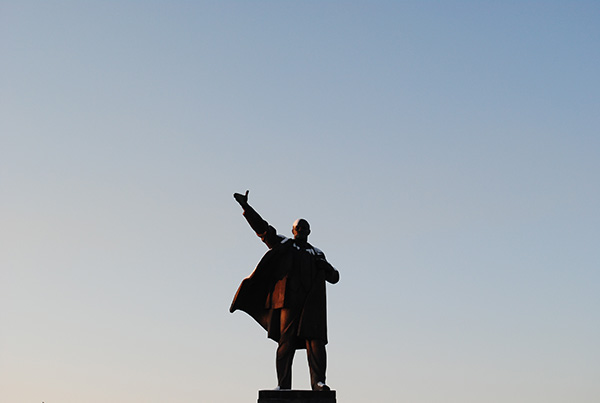Original version in Spanish: ¿Cómo celebran los rusos el centenario de la Revolución?
Theme
Russian attitudes towards the historical legacy of the Revolution are ambiguous.
Summary
For the current Russian government, the 100th anniversary of the Revolution is not a happy occasion. The Kremlin links the surge of the Bolsheviks to power to State weakness and to political and social disorder, the reoccurrence of which should not be tolerated.
Nevertheless, since Vladimir Putin took office in 2000, the regime has rehabilitated the historical figure of Joseph Stalin (1878-1953) and in 2016 inaugurated monuments to Ivan the Terrible (1530-84) and Catherine the Great (1729-96), and to Prince Vladimir, who accepted, in his own name and in those of all his subjects, the faith of Byzantine Orthodox Christianity in 988. These four figures –all very different from one another– embody the autocratic, centralised and expansionist state model, based on the values of the Orthodox Church.
The attitude of the Russians towards the historical legacy of the Revolution is ambiguous and confused, leading to a sense of apathy with respect to the current regime, as revealed by the Levada Centre surveys, conducted every October since 1990.
Analysis
Brief balance of the Russian Revolution, 100 years later
One-hundred years later, the Bolshevik Revolution and its ideology have been discredited in the wake of the collapse of the political and economic system of the Soviet Union and the communist regimes around the world. Still, it is worth remembering its roots and the characteristics of the totalitarian regime that emerged from them, given that its lasted for 70 years and decisively influenced the history of the world during the 20th century.
The Russian Revolution brought about the fall of the Czarist autocracy and the radical destruction of the political system between February and October of 1917 (according to the Julian calendar –in use in Russian until 1 January 1918– and 13 days behind the Gregorian calendar). In contrast to previous revolutions, however, it was preceded by decades of intellectual debate over the necessity, possibility and convenience of undertaking a revolution. This could be attributed to several factors: the failure of governmental reforms during the second half of the 19th century, the frustrated attempt to establish a constitutional regime from 1905 until 1917 and a relatively long tradition of revolutionary movements. Nevertheless, what would typically strictly be called the October Revolution was provoked by a coup d’état carried out by a minority group (the Bolshevik faction of the Russian Social Democratic Labour Party) from which would emerge the Soviet system and its recourse to permanent terror. Thanks to a powerful propaganda machine, and the work of official historians and the collaboration of many intellectuals and workers from other countries, the Communist Party of the Soviet Union could create the myth of the proletarian revolution.
From 1917 the Bolsheviks –inspired as much by the ideas of historic Russian populism as by those of Marxism– invented a new political, economic and social system: the Soviet state. They aspired to make utopia into reality and to build a world community of emancipated humanity, liberated from all previous political structures. In practice, under Leninism the state authority of the single party was strengthened, along with autocratic ideology, legal nihilism and an ultra-centralised administration, while individual liberties and private property were absent. Stalin preserved the basic elements of Leninism, but introduced some new ones: he further centralised the administration, unleashed the Great Terror of the 1930s and based the legitimacy of his power on the glorification of state power, hierarchical and patriotic values, and in the cult of personality. None of the subsequent Soviet leaders –Nikita Khrushchev, Leonid Brezhnev or Mikhail Gorbachev– was able to completely eradicate Stalinism from Russian society. All three criticised the inefficacy of the communist system, but failed to go any further because they did not challenge its ideological principles. Finally, when Gorbachev opted for the reforms he initiated, it became clear that the Soviet regime could not assimilate them because the democratic and Soviet systems were simply incompatible.
The systematic use of force by the Communist state to eliminate any opposition to the regime was one of the keys to the long life of the totalitarian Soviet state. But there were others. The Soviet communist system was a system of ‘compensations’. The Soviet people did not try to protect their rights –because they had none– but they instead strove to receive significant ‘compensations’, which led to the generalised corruption of society. To this mix of force, remuneration and privileges must be added the element of agitation. Party expulsions, industrial production quotas, regional rivalries, systematic denunciations between neighbours and friends and, in the end, competition with the West, all contributed to maintain euphoria as a stabilisation mechanism. It is undeniable that communist totalitarianism was not a system based on terror alone; it enjoyed a certain amount of collaboration and acceptance amongst Soviet citizenry.
The Soviet order had some extraordinary successes that were indispensable to its survival: progress in education, accelerated industrialisation, the construction of cities, victory in the Second World War and the supremacy that came with being a great military power and epicentre of world communism. The borders of the Soviet Union coincided with those of the Czarist Empire, but its dominion extended far beyond, into Eastern Europe. In contrast with the Czars, the Bolsheviks had two empires, one ‘internal’ (the USSR) and the other ‘external’ (the member countries of the Warsaw Pact).
But the costs of the longevity of communist authority –systematic terror and agitation– outweigh the achievements. The lauded successes of industrialisation and military power were temporary because they could not serve as a foundation for continuing economic modernisation unless the Soviet order were dismantled. The absence of freedom of thought or expression (key ingredients for the reinvention of a society) and the planned economy were counterproductive for economic, political and social development.
Putin and the Czars
The Bolshevik state established by Lenin was far more absolutist and tyrannical that its Czarist predecessor, but it took advantage up, and built upon, the structure of the ‘Patrimonial State’ (a state model whose institutions make no distinction between public powers and private property, with a centralised administration and an absence of individual freedoms or private property for the majority of the Czar’s subjects).
The popularity of Vladimir Putin (before the annexation of Crimea in 2014) came from his success in reconstructing the centralised model of the state. Russian citizens who support him see him as a saviour, a charismatic leader capable of dealing with the traumatic experience of the three great historical ruptures that Russia endured in the 20th century: the October Revolution (1917), the disintegration of the Soviet Union (1991) and the collapse of the Russian state in 1998. Indeed, the fact that the Kremlin introduced, in 2005, the celebration of 4 November as a festival of Russian Popular Unity foreshadows an intention to substitute it for the festival of 7 November –the anniversary of the Bolshevik Revolution (following the Gregorian calendar)– and suggests that Putin aspires to become the symbol of the overcoming of all of these historic ruptures.
The date of 4 November is the anniversary of the popular uprising of 1612 and of the expulsion of the Poles and Lithuanians who took advantage of the Smutnoye vremya (‘the time of troubles’, which followed upon the death of Czar Ivan IV the Terrible) to conquer part of the Principality of Moscow and install an imposter, Dmitri, as Czar. The event led to the arrival to the throne of Czar Michael Romanov in 1613, marking the end of the ‘time of troubles’ and the beginning of the long presence of the Romanovs on the throne (1613-1917). The new festival did not enjoy much following among the Russian people until the annexation of Crimea in 2014, when it became an affirmation of the strength and pride of Russia. But the celebration of the festival of Popular Unity in 2016 was marked by the inauguration of the monument to Prince Vladimir (17.5 metres in height) who in 988 adopted the Byzantine Orthodox Christian faith, in the environs of Sevastopol, on the Crimean Peninsula. The statue of Prince Vladimir was installed near the Kremlin and in his address Putin highlighted the centralising role of the prince, and declared that ‘the common duty of Russians today is to face modern challenges and threats, supporting ourselves with the invaluable traditions of unity and agreement, and to carry on, assuring the continuity of our millenary history’.
The inauguration of the monument to Catherine the Great –who in 1783 annexed Crimea into the Russian Empire (from the Ottomans)– took place only a few days before, in August 2016 in Simferopol (the administrative capital of the Crimea). On 14 October 2016, in Oreol, another monument was inaugurated: this one to Czar Ivan the Terrible, an historical figure known not so much for the expansion of the state as for a series of reforms which strengthened central power. In 1549 Ivan established the gleb (taxes), the Zemski sabor (the council of the representatives of the small villages) and the personal guard, or streltsi (‘archers’) –considered the precursors of the Cheka (the secret service created by the Bolsheviks in December 1917) for their cruelty in the repression of the adversaries of the Czar–. Between 1564 and 1572, following the orders of the Czar, the streltsi executed the majority of the boyars accused of conspiracy and treason. The principal objective of this arbitrary and bloody process, known as oprichnina, was to destroy the privileges of the powerful hereditary aristocracy in order to centralise power and extend the authority of the Czar.
These homages to the Russian Czars are the product of decision-making processes, operating at different levels of the administration, that seek to substitute the system of symbolic references from the communist era with other older references from Orthodox Christianity and Czarist autocracy, and insist upon the supposed splendour of imperial Russia.
Putin and the Bolsheviks
The relationship between the Kremlin and the Bolsheviks is very complex and for various reasons: the autocratic model of the current Russian regime maintains elements from the centralised Soviet state, created by the Bolsheviks, in which the security forces constitute the principal instrument for exercising control over the population. But there still is no narrative on the historical memory of the Soviet era, given the difficulty in reconciling the failure of the communist system with the most glorious period of its existence, when the USSR was a superpower.
According to the Levada Centre1 survey conducted last April, 48% of the Russian population held a positive view of the overthrow of the Romanov dynasty and the October Revolution, while 31% had a very negative view and 21% claimed that it was very difficult to define their opinion. Of those surveyed, 35% consider the arrival to power of the Bolsheviks in 1917 to have been legal (in 2003, the figure had been 42%), while 45% thought it was an illegal act (compared with 39% in 2003). In both 2003 and 2017, 19% did not know how to respond. The results express mixed sentiments: Russians think that the overthrow of the Czarist monarchy ‘was no great loss’ but such a judgement reflects the vacillating, ambiguous and ill-defined attitude of the current government of Vladimir Putin towards the Bolshevik Revolution.
The Russian Revolution is inseparable from the coup d’état, the emergence of the totalitarian state, the millions of deaths from forced collectivisation and the Great Terror of Stalin. The Kremlin views 1917 as a moment of tremendous political and social disorder that had resulted from the weakness of the state.
When Vladimir Putin assumed power in 2000 his priority was to reconstruct a strong and centralised state. To do this, he sought the approval of his compatriots, juxtaposing the restoration of order with the disorder that surrounded the disintegration of the Soviet Union and the chaotic years of the 1990s.
Although the Kremlin does not consider it appropriate to celebrate the anniversary of the October Revolution, it does not deprive itself of the use the image of Stalin and the Soviet victory in the Second World War as symbols for its own autocratic regime. Last year, on 7 November, the 99th anniversary of the Russian Revolution, the Kremlin organised a military parade commemorating that date in 1941. On that occasion, Soviet troops marched through Red Square, departing to fight the Nazis. With this ceremony, Putin substituted Bolshevism with nationalism and pride in the victory in the Great Patriotic War. This gesture not only smacks of a manoeuvre to cloud the memory of a disagreeable historical fact, but also, above all, of the need to adapt Soviet symbols to the traditional version of the Russian state model (the citizen without power in the face of the omnipotent centralised state).
As seen from a survey conducted by the Carnegie Endowment for International Peace and the Levada Centre in 2012 and 2013, there has been a symbolic recovery of the figure of Stalin –attributed to implicitly Soviet elements within Putin’s regime– although without a direct glorification of his historical role.
In the Soviet Union, in 1989, only 12% of Russians defined Stalin as ‘one of the prominent persons who have had a significant influence on the history of the world’. Stalin ranked 11th among 100 figures, with Lenin occupying first place (72% of those surveyed defined Lenin as the greatest figure in world history), ahead of Marx (35%), Czar Peter the Great (38%) and Pushkin (25%).2 Between 1989 and 2012 the perceptions of Russians changed significantly. Since 2012, Stalin has become the most towering figure to 49% of Russians.
Opinions of the historical legacy of Stalin are opposed and contradictory: 50% of those surveyed believe that Stalin was a wise leader who brought greatness and prosperity to the Soviet Union (compared with 37% who do not). Some 68% were in agreement that Stalin was a cruel and inhumane tyrant, and responsible for millions of deaths of innocent people (compared with 15% who disagree with this evaluation); but the same 68% consider that, in spite of ‘his errors’, the most important part of his legacy is the victory in the Great Patriotic War (compared with 16% who deny that this was important).
Such contradiction reflects the paradoxical perception of Stalin as the tyrant responsible for millions of deaths of his compatriots and, at the same time, as the wise and powerful leader who won the war against Hitler. In the post-Soviet psyche, national greatness is inseparable from violence and brutal force. One aspect of this perception is the widespread consciousness among Russians that they belong to a great and victorious nation. This point of view is based on the victory of the Soviet Union in 1945, one of the few cases of consensus memory, and an unimpeachable pillar of national pride. Putin’s government rests upon the centrality of the victory over Nazi Germany in the memory of Russians, and it has intensified the celebration of 9 May (‘Victory Day’) with each passing year.
The overriding importance of the Second World War and of Stalin as the commander-in-chief who delivered the nation to victory derives from the fact that unequivocal condemnation of Stalinism is impossible in Russia. In Putin’s Russia, no longer a superpower, Stalin also constitutes a form of psychic ‘compensation’ for the loss of status. His image as destroyer of Nazi Germany and leader of the superpower that faced off the US during the Cold War helps Russia to compensate for the humiliation it suffered after the collapse of the communist empire.
The perception of Stalin that is linked to the victimization and impotence of the people in the face of arbitrary governments and brutal leaders is less direct. Russian historical experience has taught people that nothing can be done against the autocratic state and that the best strategy is to adapt to its capricious will. The experience has generated a mentality of dependence and political apathy, and an acceptance of state paternalism as natural.
The surprising resurgence in the popularity of Stalin stems not from a change in the evaluation of his historical role, but rather from the political climate of the present period. The Russia of Vladimir Putin needs symbols of authority and national strength, as controversial as they might be, to validate the new authoritarian political order. Stalin –a despotic leader responsible for the massive shedding of blood but identified with resistance and victory in the Great Patriotic War and national unity– satisfies this need for affirmation of the new Russian political identity.
Conclusion
The Kremlin’s attitude towards the Russian Revolution borders on the schizophrenic: it censures the political and social disorder that it provoked but it praises its model of State, which was incomparably more tyrannical than that of the Czars.
Mira Milosevich-Juaristi
Senior Research Analyst at the Elcano Royal Institute and Associate Professor in the History of International Relations at the Instituto de Empresa | @MiraMilosevich1
1 See Survey: The October Revolution, Levada Center.
2 ‘The Stalin puzzle: deciphering post-Soviet public opinion’, Carnegie Endowment for International Peace, 1/III/2013.



